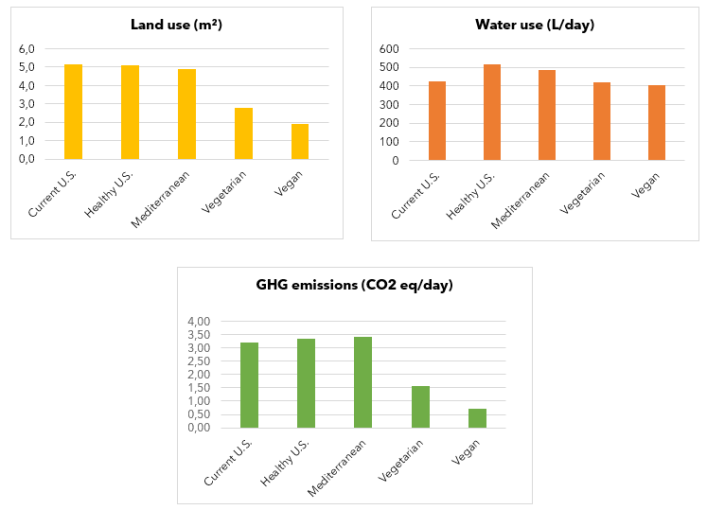U.S. dietary patterns: shift towards a vegetarian/vegan dietary pattern and less red meat for a more sustainable diet

The U.S. agri-food system has significant environmental impacts in terms of climate change, greenhouse gas emissions, land use and water use. In order to face this challenge and make U.S. food systems more sustainable, a shift in American dietary patterns is critical. The present study is a unique environmental assessment of U.S. dietary patterns. It aims to determine the environmental impact of five different U.S. dietary patterns as well as the specific impact of each food subgroup within each dietary pattern with three indicators: GHG emission, land use and water use. According to this work, omnivore diets contributed the greatest to GHG emissions, land use and water use- red meat and dairy milk being the major contributors- whereas the Vegan diet scored the lowest across all indicators.
Agriculture and forestry in the U.S. have significant environmental impacts. Together, they are estimated to account for 11.2% of GHG emissions (USDA, 2022). Moreover, agriculture uses approximately 80% of U.S. total ground and surface water (USDA, 2019), and exploits 65% of U.S. land for grazed forestland, pastures and ranges, and cropland (Nickerson et al., 2012). According to the EAT-Lancet report, one potential impactful strategy to face this challenge and increasing the sustainability of our global food system is changing dietary behaviors, specifically adopting more sustainable diets than the current Western dietary patterns with less meat and dairies (Willett et al., 2019; Aleksandrowicz et al., 2016; Soret et al., 2014; Garnett et al., 2011).
Yet, much of the literature referenced in EAT-Lancet report has been conducted in European countries. Only few studies conducted in North America focused on the U.S. food system. Additionally, the types of dietary behaviors and food items examined in the U.S. studies were limited, and/or only one climate indicator was examined in isolation rather than multiple indicators simultaneously. Therefore, the present study (Jennings et al., 2023) aims to determine the environmental impact with three indicators, using U.S. environmental data, of five different U.S. dietary patterns: the Current U. S., the Healthy U. S., Healthy Mediterranean, Healthy Vegetarian, and Vegan. The specific impact of each food subgroup within each dietary pattern on the three environmental indicators was also examined.
Omnivore dietary patterns have greater environmental impacts on land use, water use and GHG emissions than vegetarian and vegan die
The three omnivore diets contributed the greatest to all three environmental indicators studied in the present paper (i.e., land use, water use and GHG emissions). In contrast, vegetarian and vegan diets have the lowest impacts on environmental indicators.
As shown in figure 1, current U.S diet had the greatest land use, followed by healthy U.S. and Mediterranean diet. For water use indicator, healthy U.S. had the highest impact, followed by Mediterranean diet and current U.S. Finally, for GHG emissions, mediterranean diet contributed the most, followed by healthy U.S. and current U.S. diet.

Red meat is the major contributor to all indicators in omnivore dietary patterns
When examining the specific impact of each food subgroup within each dietary pattern on the three environmental impacts, the results showed that red meat had the greatest contribution to all indicators in the case of the three omnivore diets. Dairy milk is also of concern for all three indicators, and low omega-3 fish for GHG emissions.
As regards the two dietary patterns that do not include animal protein (i.e., vegetarian and vegan), the dairy food group and the nuts/seeds food group score the highest GHG emissions. For water use, the nuts/seeds group contribute the most in the vegan pattern, while dairy milk in the vegetarian pattern. Lastly, for land use, dairy milk, dairy cheese, and whole grains are the largest contributors in the vegetarian diet, while whole grains and refined grains contribute the most in the vegan diet.
More work is needed to understand how to encourage individuals to adopt sustainable dietary behaviors
The findings of this unique environmental assessment of U.S. dietary patterns provide environmental data, beyond GHG emissions, to facilitate a deeper reflection on the potential trade-offs of dietary patterns. However, many environmental, economic, and social externalities such as nutritional adequacy, cultural acceptability, optimization of human resources, and economic affordability were not included in this analysis but should be considered to potentially add to a more holistic view of the sustainability of diets.
According to this work, switching to dietary patterns characterized by less red meat, such as the vegan vegetarian dietary patterns, will lead to a reduction in land use, water use, as well as in GHG emissions, for per-capita food production, based on current practices, and thus greater food security. What remains to be studied and understood is how to encourage individuals to make this transition towards more sustainable dietary behaviors in order to foster greater household food security in the U.S. and globally.
Based on: Jennings R., et al. Five U.S. Dietary Patterns and Their Relationship to Land Use, Water Use, and Greenhouse Gas Emissions: Implications for Future Food Security. Nutrients, 2023; 15(1): 215.
- The three omnivore diets contributed the greatest to GHG emissions, land use and water use, whereas the Vegan diet scored the lowest across all indicators.
- Red meat is the major contributor to all indicators in omnivore dietary patterns.
- In vegetarian and vegan dietary patterns, dairy foods, nuts/seeds, and grains are the major contributors to environmental impacts.
- Switching to dietary patterns characterized by less red meat, such as the vegan vegetarian dietary patterns, will lead to a reduction in land use, water use, as well as in GHG emissions, for per-capita food production, based on current practices, and thus greater food security.
